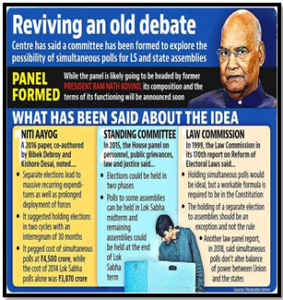“ONE NATION, ONE ELECTION”
Syllabus :
- GS 2 :Federalism & Representation of People’s Act
Focus:
- In September 2023, the Union Government established a High-Level Committee on “One Nation, One Election” under the leadership of former President Ramnath Kovind.
- This initiative, aimed at synchronizing elections to the Lok Sabha and State Legislative Assemblies, has sparked considerable debate.
- As this could potentially reshape India’s democratic framework, it is crucial to delve into the legal implications surrounding this proposal.
Source : UGI
About the Committee:
- The High-Level Committee, formed ahead of the 2024 general elections, has engaged national and state political parties and sought public and jurists’ opinions.
- While no definitive timeline is set, concerns arise about the potential impact on the federal structure, necessitating a closer examination of legal issues.
Understandings One Nation, One Election
Historical Background
- Till 1967, there was a synchronized schedule for Lok Sabha and State Assembly elections.
- Disruptions ensued due to reasons like defections, dismissals, and dissolutions of governments.
- The cycle was broken in 1959 when Article 356 was invoked to dismiss the Kerala government.
Current Scenario :
Presently, certain states like Arunachal Pradesh, Sikkim, Andhra Pradesh, and Odisha already hold simultaneous elections with the Lok Sabha.
Advocacy by Law Commission :
In 1999, the Law Commission, led by BP Jeevan Reddy, advocated the idea of conducting simultaneous elections.
Benefits of One Nation, One Election
Focused Governance :
- Enables the government to concentrate on governance post-elections.
- Frequent elections cause administrative paralysis, affecting India’s growth prospects.
Continuity in Policy Decisions
- Model Code of Conduct during elections delays new policy decisions.
- Implementation of ongoing projects is disrupted during election periods.
Reduced Cost
- Drastically reduces election expenses for political parties.
- Savings for the public and business community from repetitive fundraising.
Reduced Deployment of Security Forces
- Cuts down on the massive deployment of police personnel and paramilitary forces.
- Reduces diversion of law enforcement personnel from critical functions.
End of Horse Trading
- Fixed election intervals may discourage elected representatives from indulging in horse-trading.
Improved State Finances
- Less frequent elections could lead to reduced financial strain on state governments.
Challenges Associated with One Nation, One Election
Feasibility and Constitutional Issues
- Raises questions about what happens if a government collapses mid-tenure.
- Potential imposition of President’s rule or holding elections again.
Logistical Challenges
- Poses challenges in terms of managing electronic voting machines, personnel, and other resources.
- Requires efficient coordination and resource allocation by the Election Commission.
Federalism Concerns
- Contradicts the concept of federalism, as India is envisaged as a “Union of States” in Article 1.
- The constitutional courts, particularly the Supreme Court, might need to navigate this complex issue to ensure the preservation of India’s federal structure.
Legal Challenges
- The existing constitutional framework and laws may need amendments for simultaneous elections.
- Recommendations for ratification from at least 50% of the States pose a significant challenge.
Overshadowing Regional Interests
- Simultaneous elections may undermine distinct demands and needs of each state.
- Studies suggest a high likelihood of winning both Lok Sabha and Assembly elections simultaneously.
Cost Effectiveness Debate
- Estimates vary regarding the actual cost savings of simultaneous elections.
- Initial investment for infrastructure might outweigh short-term savings.
Legal Concerns
- Constitutional Independence of States: In S.R. Bommai v. Union of India (1994), the Supreme Court emphasized states’ independent constitutional existence. Common elections might necessitate altering the tenure of State Legislatures, challenging constitutional principles.
- Language Bias: The High-Level Committee’s website, available only in English and Hindi, raises concerns about inclusivity in a country with 22 official languages.
- Election Commission Autonomy: Similar to the demonetization episode, where the Reserve Bank of India was kept uninformed, the Election Commission’s apparent silence questions its autonomy.
- Judicial Review Powers:
In India’s constitutional framework, higher courts hold broad powers of judicial review to scrutinize executive actions that exceed their designated domains.
Way Forward :
Building Consensus
Dialogue and consultation among political parties and states to build consensus.
Constitutional Amendments
Amendments to the Constitution, Representation of the People Act 1951, and Rules of Procedure of Lok Sabha and State Assemblies.
Infrastructure Investment
Invest in infrastructure and technology required for simultaneous elections.
Term Alignment
Align the electoral cycles of Lok Sabha and State Assemblies through constitutional amendments.
Legal Framework
Establish a legal framework for handling situations like no-confidence motions, premature dissolutions, and hung parliaments during simultaneous elections.
Twice-Yearly Cycles
Consider holding simultaneous elections twice a year to accommodate premature dissolutions.
Voter Awareness
Create awareness among voters about the benefits and challenges of simultaneous elections.
The “One Nation, One Election” proposal, while intending to streamline the electoral process, raises significant legal concerns regarding federalism, linguistic inclusivity, and the autonomy of constitutional bodies. As the High-Level Committee progresses, the nation awaits a constitutional verdict on whether simultaneous elections align with the principles embedded in India’s democratic foundation. The Supreme Court’s role is pivotal in determining the fate of this proposal and its implications on the diverse and federal character of the country.
Source :
Mains Practice Question :
Critically assess the viability and implications of the “One Nation, One Election” proposal in India.

 Source : UGI
Source : UGI

